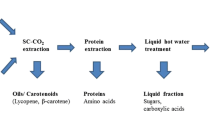Abstract
The increase of waste quantities from tomato processing industry is an important ecological and also financial problem. Seeds are the major component of this waste and one valuable alternative of transforming them into raw materials is oil extraction. The isolated oil can be used for nutritive or industrial purposes. In this research, the influence of some extraction parameters (time, solvent and granularity of tomato milled seeds) on the fatty acid (FA) composition, water content and water reaction rate has been evaluated. The FA composition of tomato seed oil, determined by gas chromatography–mass spectrometry, has shown a high content of linoleic acid (20.8–39.9 mg/mL), followed by palmitic acid (6.3–19.3 mg/mL), oleic acid (2.5–14.2 mg/mL), linolenic acid (0.7–4.9 mg/mL), stearic acid (0.1–0.8 mg/mL), palmitoleic acid (0.03–0.5 mg/mL), arachidic acid (0.08–0.4 mg/mL), myristic acid (0.05–0.2 mg/mL) and margaric acid (0.02–0.11 mg/mL). The oil content of tomato seeds was registered in the range of 13.3–19.3 %. For evaluation of water content, a method using Karl Fischer titration (KFT) has been established. Comparing with the physical methods that do not distinguish the water content from volatile matter, KFT is an important technique, very accurate, that determines water content by a chemical reaction.



Similar content being viewed by others
References
Battaglia L (1901) Ricerche sull olio dei semi di pomodoro. Ann Soc Chini Milano 3(4):127
Rabak F (1917) The utilization of waste tomato seeds and skins. Bull US Dep Agric 632:1–15
Dabrowska M (1970) Utilisation of tomato seed for oil production. Prace Inst i Lab Badaw Przemysz Spoz 20:511–522
Giannelos PN, Sxizas S, Lois E, Zannikos F, Anastopoulus G (2005) Physical, chemical and fuel related properties of tomato seed oil for evaluating its direct use in diesel engines. Ind Crop Prod 22:193–199
Lazos ES, Tsaknis J, Lalas S (1998) Characteristics and composition of tomato seed oil. Grasas Aceites 49:440–445
Eller FJ, Moser JK, Kenar JA, Taylor SL (2010) Extraction and analysis of tomato seed oil. J Am Oil Chem Soc 87:755–762
Xin-yu S, Shi-ying X (2005) Supercritical CO2 extraction of tomato seed oil. J Food Tech 3:226–231
Lazos E, Kalathenos P (1988) Technical note: composition of tomato processing wastes. Int J Food Sci Tech 23:649–652
Cantarelli PR, Regitano-d’Arce MAB, Palma ER (1993) Physicochemical characteristics and fatty acid composition of tomato seed oils from processing wastes. Sci Agric (Piracicaba, Braz) 50:117–120
Bailey HS, Burnett LB (1914) Tomato-seed oil. Science 39:953
Al-Wandawi H, Rahman MA, Al-Shaikhly K (1985) Tomato processing wastes as essential raw materials source. J Agric Food Chem 33:804–807
Thiex N, Richardson CR (2003) Challenges in measuring moisture content of feeds. J Anim Sci 81:3255–3266
Hădărugă NG, Hădărugă DI, Isengard H-D (2012) Water content of natural cyclodextrins and their essential oil complexes: a comparative study between Karl Fischer titration and thermal methods. Food Chem 132:1741–1748
Felgner A, Schlink P, Kirschenbühler P, Faas B, Isengard H-D (2008) Automated Karl Fischer titration for liquid samples—water determination in edible oils. Food Chem 106:1379–1384
Hădărugă NG, Hădărugă DI, Păunescu V, Tatu C, Ordodi VL, Bandur G, Lupea AX (2006) Bioactive nanoparticles (6). Thermal stability of linoleic acid/α- and β-cyclodextrin complexes. Food Chem 99:500–508
Dieffenbacher A, Pocklington WD (1992) Standard methods for the analysis of oils, fats and derivatives, 7 (1st suppl) edn. Blackwell Science, Oxford
Hallahan B, Garland MR (2005) Essential fatty acids and mental health. Br J Psychiatry 186:275–277
Singh M (2005) Essential fatty acids, DHA and human brain. Indian J Pediatr 72:239–242
Bruice PY (2010) An introduction to organic compounds. Physical properties of alkanes, alkyl halides, alcohols, ethers, and amines. In: Organic chemistry, 6th edn. Prentice Hall, Upper Saddle River, pp 96–97
Acknowledgments
This work was partially supported by the “Doctoral Studies for Training in Research (FOR-CE)” Program, POSDRU/CPP107/DMI1.5/S/80127, co-financed by the Structural Funds of the European Union, selected from the Sectoral Operational Programme Human Resources Development 2007–2013. The authors would like to thank Professor Heinz-Dieter Isengard from Hohenheim University, Germany, for the help in the Karl Fischer water titration.
Author information
Authors and Affiliations
Corresponding author
Rights and permissions
About this article
Cite this article
Botineştean, C., Gruia, A.T. & Jianu, I. Utilization of seeds from tomato processing wastes as raw material for oil production. J Mater Cycles Waste Manag 17, 118–124 (2015). https://doi.org/10.1007/s10163-014-0231-4
Received:
Accepted:
Published:
Issue Date:
DOI: https://doi.org/10.1007/s10163-014-0231-4




